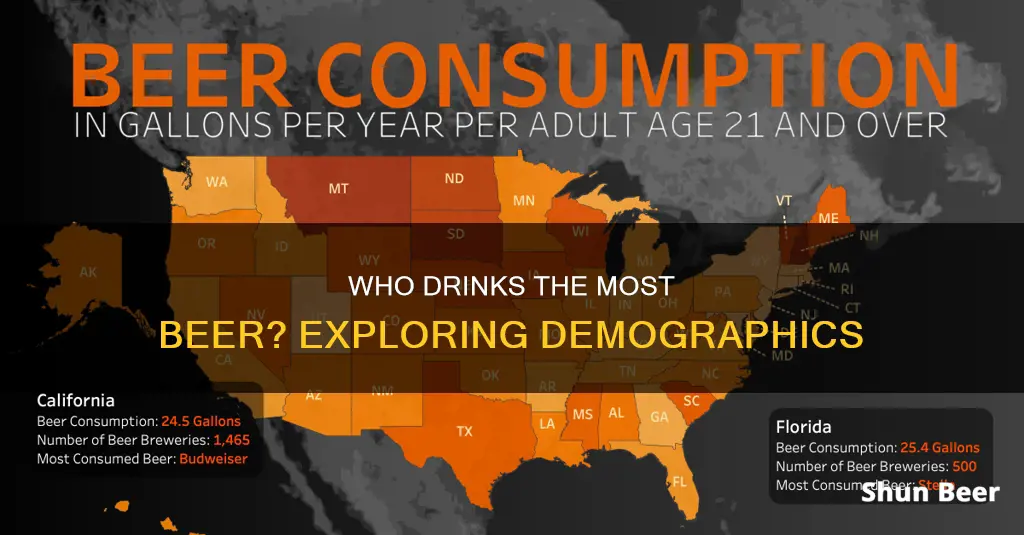
Beer is the world's most popular alcoholic beverage, with China, the US, and Brazil being the top three largest consumers. In the US, beer is the most popular alcoholic beverage, with 60% of adults drinking alcohol, and beer representing the largest segment of the beverage alcohol industry. However, beer has been losing market share to wine and spirits. In terms of demographics, men are more likely to drink beer than women, and beer is also more popular among younger adults, those with lower incomes, and those without a college education. When it comes to race and ethnicity, the data shows that while the number of minority craft beer drinkers is growing, the percentage of white drinkers remains high, indicating a lack of diversity in craft beer consumption.
| Characteristics | Values |
|---|---|
| Country that drinks the most beer | Gabon |
| Second-highest beer consumption | Czech Republic |
| Third-highest beer consumption | Austria |
| Largest beer markets worldwide | China, the U.S., and Brazil |
| Top-selling beer in the U.S. in 2022 | Bud Light |
| Top-selling beer in the U.S. in 2023 | Modelo Especial |
| Beer drinkers by gender | 63% men, 37% women |
| Beer drinkers by age group | 18-34 |
| Beer drinkers by education | Not college-educated |
| Beer drinkers by income | Less than $40,000 and between $40,000 and $99,999 |
What You'll Learn
- Gender: Men drink more beer than women
- Age: Younger consumers (aged 18-34) drink more beer than older consumers
- Education: Non-college-educated people drink more beer
- Income: People with an income of less than $100,000 drink more beer
- Race/ethnicity: White people are the largest demographic of beer drinkers

Gender: Men drink more beer than women
Beer is the world's most popular alcoholic beverage, with the largest segment of the beverage alcohol industry represented by beer. In the United States alone, citizens consume 6.5 billion gallons of beer annually. However, the US does not even rank in the top 15 countries for beer consumption per capita. This distinction goes to Gabon, where citizens consume an average of 6.37 liters of ethanol from beer per person each year.
When it comes to demographics, men drink more beer than women. In the US, 63% of men consume alcoholic beverages, compared to 57% of women. This gender disparity is also reflected in the types of alcoholic beverages preferred, with beer being the most frequently consumed drink by men, while women prefer wine.
The gender gap in beer consumption is not limited to the US. For example, in China, the world's largest beer consumer and producer, men between the ages of 25 and 34 are the target market for Budweiser, one of the country's top-selling beer brands. Similarly, in the craft beer segment, men outnumber women, with 68.5% of craft drinkers being male and 31.5% female.
While the gender gap in beer consumption exists, it is worth noting that the situation is improving over time. For instance, between 2015 and 2018, the percentage of female craft beer drinkers in the US increased from 29.1% to 31.5%, indicating a shift towards greater gender parity in beer consumption.
Beer and Macros: Can You Drink and Stay on Track?
You may want to see also

Age: Younger consumers (aged 18-34) drink more beer than older consumers
When it comes to beer consumption, age is a significant factor. According to Gallup's report in 2021, consumers between the ages of 18 and 34 drank beer the most. This younger demographic, also known as Gen Z, has shown a preference for beer over other alcoholic beverages.
Gen Z's drinking habits differ from those of Millennials, who are slightly older. While 90% of Millennials purchased alcohol in a 52-week period ending in May 2021, the percentage was slightly lower for Gen Z, at 84%. Gen Z also spent 40% less on alcohol and made five fewer trips per year to purchase it. They were also less likely to consume beer regularly compared to Millennials.
The reasons behind Gen Z's lower alcohol consumption may lie in their concerns about alcohol's impact on their mood, alertness, and social media image. They also tend to spend less on alcohol and make fewer trips to purchase it. However, when they do consume alcohol, they are more likely to do so for the thrill of a good time and the "buzz" it provides.
In terms of gender, men are more likely to consume beer than women. This trend holds across different age groups, including the younger demographic of 18 to 34-year-olds. Additionally, income plays a role, with beer drinkers in this age group tending to have an income of less than $40,000 to $99,999.
While the younger generation drives beer consumption, it's worth noting that the beer industry is vast and diverse. It includes craft beers, imported beers, and domestic beers, with different brands catering to varying tastes and preferences.
Beer and Breastfeeding: Is It Safe to Drink?
You may want to see also

Education: Non-college-educated people drink more beer
In the United States, 60% of adults consumed alcohol in 2021, a decrease from 65% in 2019. Beer is the largest segment of the beverage alcohol industry, with overall sales volume and retail dollar sales eclipsing those of wine and spirits combined.
Education and Alcohol Consumption
According to a 2022 Gallup report, 63% of men and 57% of women in the US drank alcoholic beverages. Further, 70% of those aged 35 to 54 years consumed alcohol, compared to 60% of younger consumers and 52% of older consumers.
The same report also found that non-college-educated consumers were more likely to drink beer than their college-educated counterparts, who were more likely to drink wine.
Education and Income
The 2022 Gallup report also found that the percentage of participants who consumed alcohol increased as annual household income increased.
Education, Income, and Alcohol Consumption
A 2019 study published in the *Molecular Psychiatry* journal found that educational attainment impacts drinking behaviours and the risk of alcohol dependence. The study used Mendelian randomisation statistical methods to analyse the link between educational attainment and alcohol consumption.
The study found that:
- Genetic variants associated with higher educational attainment were not associated with the total amount of alcohol people drank in a week.
- However, higher educational attainment was associated with a reduced frequency of binge drinking, frequency of memory loss due to drinking, total drinks consumed per drinking day, and weekly intake of distilled spirits, beer, and cider.
- The association with drinking fewer spirits was more pronounced in women, while decreased average weekly beer intake was more pronounced in men.
- Higher educational attainment was also associated with more frequent drinking in both men and women, with drinking alcohol with meals (especially in men), and with higher consumption of wine.
The findings suggest that increasing educational attainment may be a useful target for prevention programs against problematic alcohol use, alcohol dependence, and their consequences.
Beer and Anemia: Is It Safe to Drink?
You may want to see also

Income: People with an income of less than $100,000 drink more beer
Income is a significant factor in determining beer consumption, with a negative correlation between earnings and beer drinking. People with an income of less than $100,000 tend to drink more beer, and this trend is consistent across various surveys.
Gallup's 2023 survey of 1,015 adults in the U.S. revealed that 62% of respondents consumed alcohol, with beer being the most frequently consumed beverage at 37%. When examining income levels, the data showed that beer drinkers typically had incomes below $100,000. This trend aligns with the findings of another Gallup survey conducted in 2021-2022, which indicated that 80% of adults with household incomes of $100,000 or higher consumed alcohol, compared to 49% of those earning less than $40,000.
The relationship between income and beer consumption is further supported by data from Alcoholic Beverage Consumption Statistics and Trends 2022. This report revealed that beer drinkers were predominantly those with an income of less than $40,000 or between $40,000 and $99,999. Additionally, the report highlighted that Gen Z and Millennial drinkers, who are more likely to have lower incomes, consumed more beer than older generations.
The preference for beer among lower-income individuals may be influenced by its affordability compared to other alcoholic beverages. Beer is often positioned as a more affordable option, making it a popular choice for those with limited financial means. This perception is particularly true for craft beer, which has experienced significant growth in recent years, driven primarily by small, independent breweries that offer innovative and traditional styles at competitive prices.
Furthermore, gender dynamics play a role in the income-beer consumption relationship. Men are more likely to consume beer than women, and when combined with income disparities, this contributes to the higher beer consumption among lower-income groups. However, it is important to note that the gender gap in beer drinking is narrowing, with more women turning to craft beer options.
Booze and Workouts: Beer vs. Bourbon's Impact
You may want to see also

Race/ethnicity: White people are the largest demographic of beer drinkers
Race and ethnicity play a role in beer consumption patterns, with white people constituting the largest demographic of beer drinkers in the United States. While beer is enjoyed by people of all races and ethnicities, its consumption is higher among white Americans. This trend is influenced by various factors, including cultural, social, economic, and historical reasons, which contribute to the racial disparity in beer drinking habits.
Cultural and social factors play a significant role in the racial demographics of beer consumption. The perception and stigma associated with alcohol consumption vary across different racial and ethnic groups. For example, in some Black communities, alcohol consumption may be viewed negatively due to religious or cultural influences, which can deter individuals from drinking beer or any alcoholic beverage. On the other hand, white communities may have different cultural norms and attitudes towards alcohol, resulting in higher beer consumption.
Economic factors also contribute to the racial disparity in beer drinking habits. Historically, Black Americans have lower incomes and less wealth compared to their white counterparts, which can influence their purchasing decisions. Craft beer, for instance, tends to be more expensive than conventional beer, and individuals with lower disposable income may opt for more affordable options or forego purchasing alcohol altogether. Additionally, racial discrimination in business practices, such as the challenges Black Americans face in obtaining business loans, can hinder the establishment of Black-owned breweries or craft beer companies.
Historical and regional factors have also played a role in shaping the racial demographics of beer consumption. The history of racism and discrimination in the American beer industry, including the exclusion of Black people from employment opportunities in breweries, has contributed to the lack of representation in the craft beer industry. Additionally, regional differences in beer preferences, such as the tendency for lighter beers in the South, can influence the types of beer consumed by different racial groups.
It is important to acknowledge that the racial disparity in beer consumption is not solely due to the choices made by different racial groups but is also influenced by broader societal factors, including systemic racism and discrimination. Addressing these issues is crucial to promoting inclusivity and diversity in the beer industry and ensuring equal opportunities for all, regardless of race or ethnicity.
Beer on Tuesday: Yay or Nay?
You may want to see also
Frequently asked questions
Gabon, where citizens drink an average of 6.37 liters of ethanol from beer per capita.
Men, consumers between 18 and 34, those without a college education, and those with an income of less than $40,000 to $99,999.
While the number of craft beer drinkers has increased, the demographic has not diversified. In 2015, 29.1% of craft drinkers were female, and in 2018, this number rose to 31.5%.
China.







